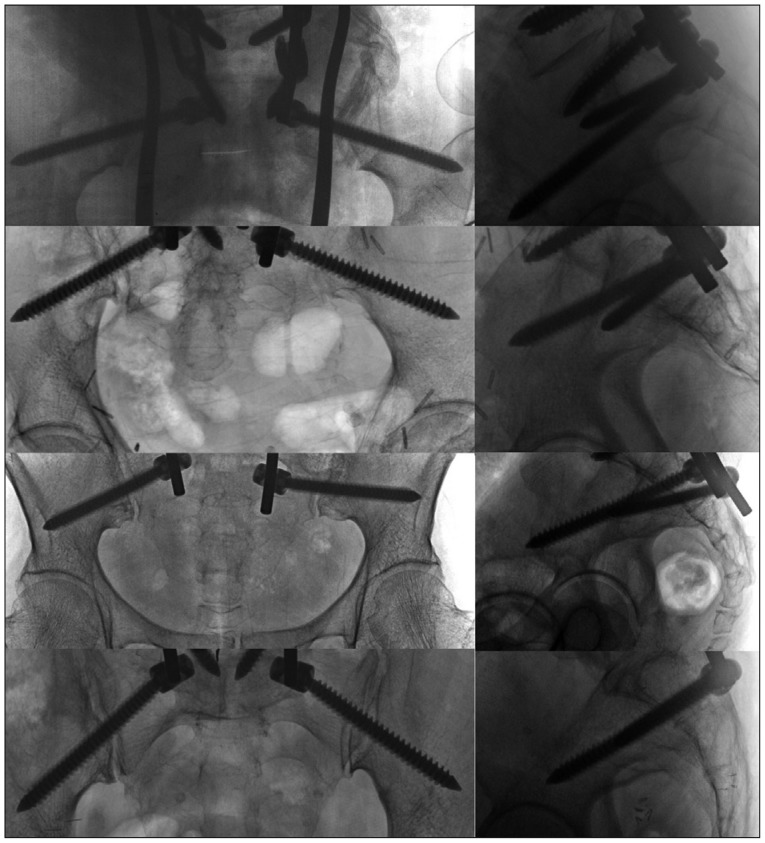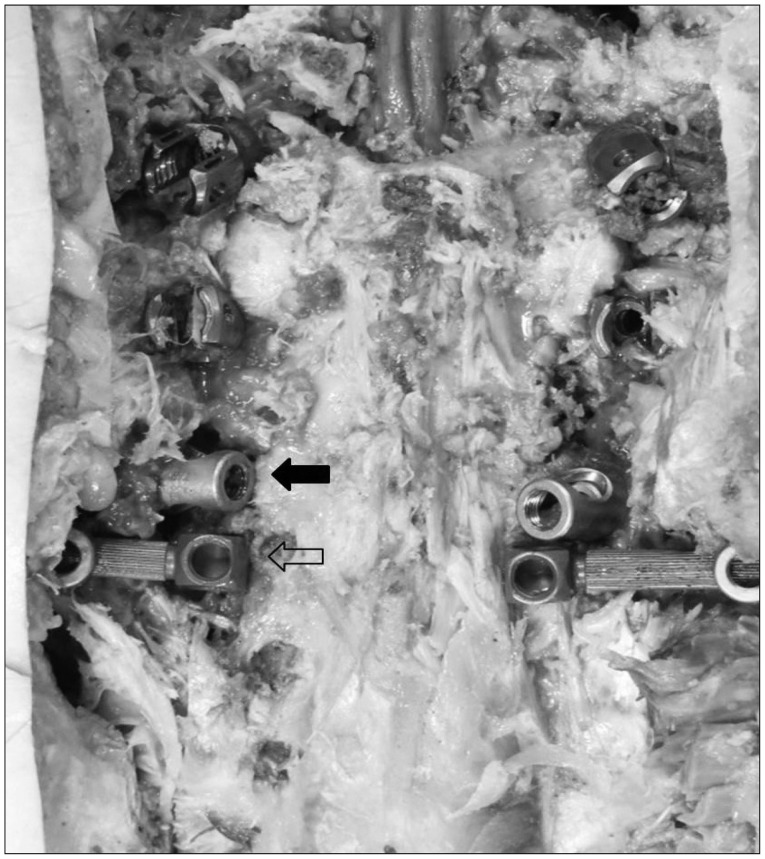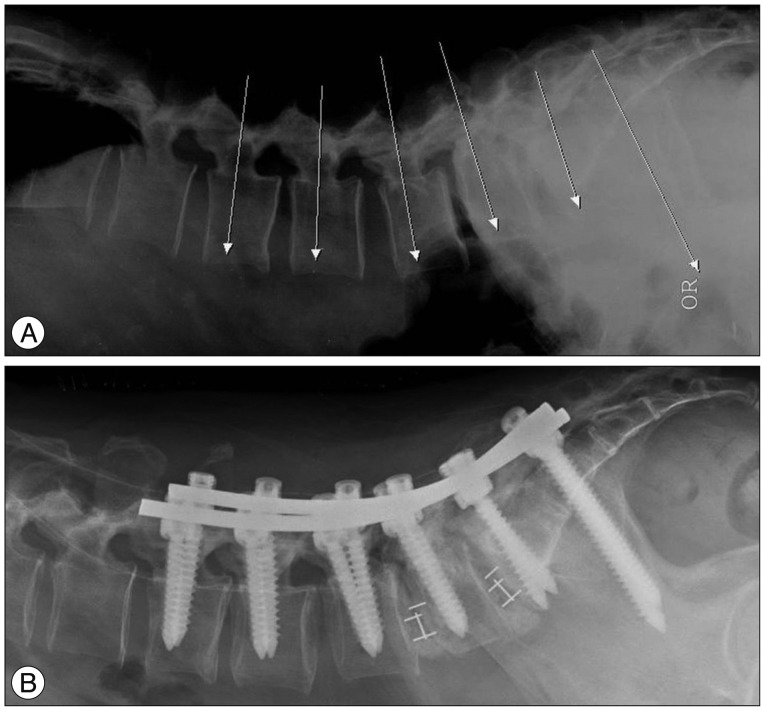J Korean Neurosurg Soc.
2015 Dec;58(6):578-581. 10.3340/jkns.2015.58.6.578.
Free Hand Insertion Technique of S2 Sacral Alar-Iliac Screws for Spino-Pelvic Fixation: Technical Note, Acadaveric Study
- Affiliations
-
- 1Department of Neurosurgery, Spine Center, Seoul National University Bundang Hospital, Seoul National University College of Medicine, Seongnam, Korea. hyunsj@snu.ac.kr
- KMID: 2151165
- DOI: http://doi.org/10.3340/jkns.2015.58.6.578
Abstract
- A rigid spino-pelvic fixation to anchor long constructs is crucial to maintain the stability of long fusion in spinal deformity surgery. Besides obtaining immediate stability and proper biomechanical strength of constructs, the S2 alar-iliac (S2AI) screws have some more advantages. Four Korean fresh-frozen human cadavers were procured. Free hand S2AI screw placement is performed using anatomic landmarks. The starting point of the S2AI screw is located at the midpoint between the S1 and S2 foramen and 2 mm medial to the lateral sacral crest. Gearshift was advanced from the desired starting point toward the sacro-iliac joint directing approximately 20degrees angulation caudally in sagittal plane and 30degrees angulation horizontally in the coronal plane connecting the posterior superior iliac spine (PSIS). We made a S2AI screw trajectory through the cancellous channel using the gearshift. We measured caudal angle in the sagittal plane and horizontal angle in the coronal plane. A total of eight S2AI screws were inserted in four cadavers. All screws inserted into the iliac crest were evaluated by C-arm and naked eye examination by two spine surgeons. Among 8 S2AI screws, all screws were accurately placed (100%). The average caudal angle in the sagittal plane was 17.3+/-5.4degrees. The average horizontal angle in the coronal plane connecting the PSIS was 32.0+/-1.8degrees. The placement of S2AI screws using the free hand technique without any radiographic guidance appears to an acceptable method of insertion without more radiation or time consuming.
Figure
Cited by 1 articles
-
Freehand S2 Alar-Iliac Screw Placement Using K-Wire and Cannulated Screw : Technical Case Series
Ho Yong Choi, Seung-Jae Hyun, Ki-Jeong Kim, Tae-Ahn Jahng, Hyun-Jib Kim
J Korean Neurosurg Soc. 2018;61(1):75-80. doi: 10.3340/jkns.2016.1212.008.
Reference
-
1. Chang TL, Sponseller PD, Kebaish KM, Fishman EK. Low profile pelvic fixation : anatomic parameters for sacral alar-iliac fixation versus traditional iliac fixation. Spine (Phila Pa 1976). 2009; 34:436–440. PMID: 19247163.2. Edwards CC 2nd, Bridwell KH, Patel A, Rinella AS, Berra A, Lenke LG. Long adult deformity fusions to L5 and the sacrum. A matched cohort analysis. Spine (Phila Pa 1976). 2004; 29:1996–2005. PMID: 15371700.
Article3. Hyun SJ, Rhim SC, Kim YJ, Kim YB. A mid-term follow-up result of spinopelvic fixation using iliac screws for lumbosacral fusion. J Korean Neurosurg Soc. 2010; 48:347–353. PMID: 21113363.
Article4. Kim YJ, Bridwell KH, Lenke LG, Cho KJ, Edwards CC 2nd, Rinella AS. Pseudarthrosis in adult spinal deformity following multisegmental instrumentation and arthrodesis. J Bone Joint Surg Am. 2006; 88:721–728. PMID: 16595461.
Article5. Mattei TA, Fassett DR. Combined S-1 and S-2 sacral alar-iliac screws as a salvage technique for pelvic fixation after pseudarthrosis and lumbosacropelvic instability : combined S-1 and S-2 sacral alar-iliac screws as a salvage technique for pelvic fixation after pseudarthrosis and lumbosacropelvic instability : technical note. J Neurosurg Spine. 2013; 19:321–330. PMID: 23808582.
Article6. O'Brien JR, Yu W, Kaufman BE, Bucklen B, Salloum K, Khalil S, et al. Biomechanical evaluation of S2 alar-iliac screws : effect of length and quad-cortical purchase as compared with iliac fixation. Spine (Phila Pa 1976). 2013; 38:E1250–E1255. PMID: 23759811.7. O'Brien JR, Yu WD, Bhatnagar R, Sponseller P, Kebaish KM. An anatomic study of the S2 iliac technique for lumbopelvic screw placement. Spine (Phila Pa 1976). 2009; 34:E439–E442. PMID: 19454996.
- Full Text Links
- Actions
-
Cited
- CITED
-
- Close
- Share
- Similar articles
-
- Freehand S2 Alar-Iliac Screw Placement Using K-Wire and Cannulated Screw: Technical Case Series
- Lumbo-sacro-pelvic Fixation Using Iliac Screws for the Complex Lumbo-sacral Fractures
- Is S1 Alar Iliac Screw a Feasible Option for Lumbosacral Fixation?: A Technical Note
- Treatment of Unstable Sacral Fractures Related to Spino-Pelvic Dissociations
- Spino-Pelvic Fixation in Unstable Sacral Fracture: A Case Report





